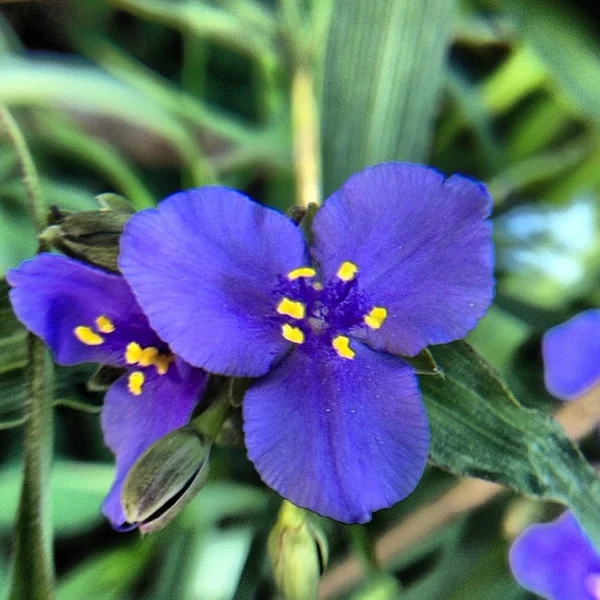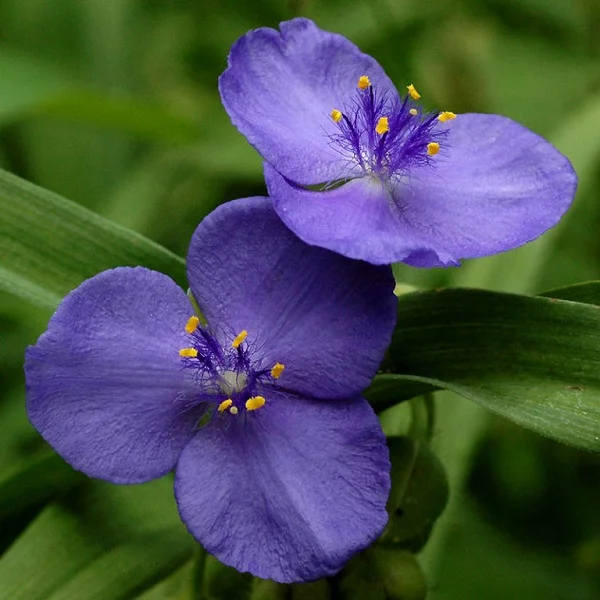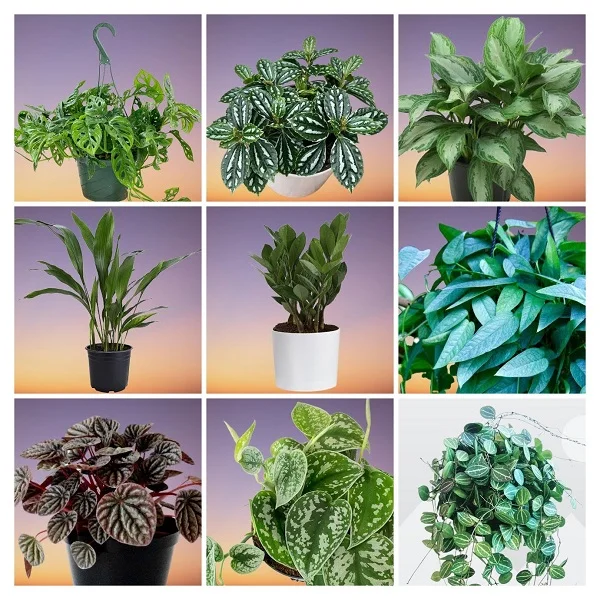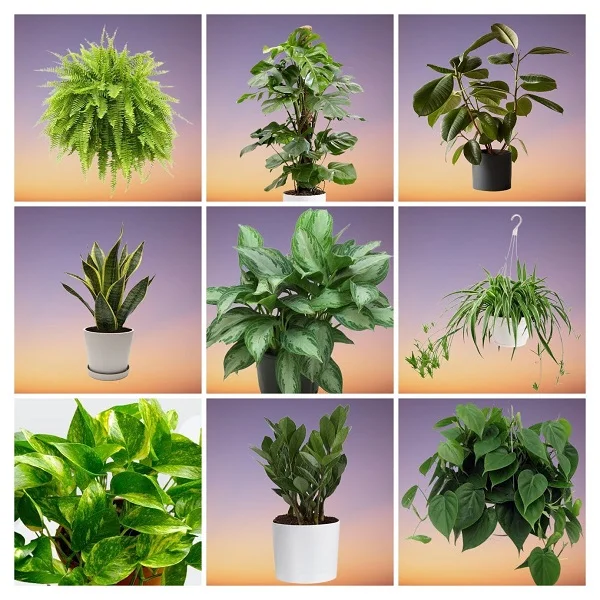Tradescantia virginiana (Virginia Spiderwort) Indoor Care, Propagation and Common Problems
Some links in this post may be affiliate links
Tradescantia virginiana (Virginia Spiderwort) flourishes in bright indirect light, average warmth, moderate humidity and consistently moist, rich, well-drained soil coupled with monthly feeding in the growing season.
Virginia Spiderwort also called Common Spiderwort or Spider Lily is one of the popular Tradescantia varieties and bears blue, purple, magenta or white flowers which are borne in summer.
Common Spiderwort is a perennial herbaceous plant with alternate, simple leaves, on tubular stems. It bears long, erect or arching bright green leaves. The plant is a prolific bloomer with each flower lasting only a day.
Virginia Spiderwort spreads by means of underground stolons forming clumps and grows 2-3 feet tall by 1 foot wide.
On account of its striking foliage and striking flowers, Spider Lily is one of the best plants for the office space as it will brighten up any space.

Botanical name: Tradescantia virginiana
Family: Commelinaceae
Common names: Virginia Spiderwort, Common Spiderwort, Spider Lily
Origin
Tradescantia virginiana is native to the eastern and central USA.
Is Virginia Spiderwort poisonous?
Virginia Spiderwort is mildly toxic to humans and pets. If ingested, the plant sap can cause burning in the mouth, tongue and throat. The sap may also cause skin irritation in sensitive skin; always wear gloves when handling this plant.
Tradescantia virginiana Care Indoors
To care Tradescantia virginiana indoors, provide bright indirect light, average warmth of 16-270C, humidity of 50-55% and consistently moist, fertile, well-drained soil coupled with monthly feeding during the growing season.
Virginia Spiderwort care requires repotting only when extremely pot-bound as it thrives when slightly root-bound. Regular pruning is needed to keep it neat, to reduce pest and disease infestations, to encourage a bushy, compact growth and to rejuvenate growth. Keep reading for more on these growing conditions and how to achieve them.

Watering
Water your Tradescantia virginiana thoroughly in spring and summer while allowing the top 1-2 inches of soil to dry out between waterings. Maintain the soil consistently moist but not soggy to avoid yellowing and leaf drop.
Water less in fall and winter to keep the soil slightly moist as growth is minimal. Do not allow the soil to dry out completely to prevent wilting and leaf drop.
Make sure that the pot has a drainage hole and the soil is well-draining to avoid waterlogging as it can lead to root-rot and death of the plant.
Light Requirements
Tradescantia virginiana grows best in bright indirect light (dappled light). Keep it away from direct sunshine as it can lead to scorching of the leaves.
Too little light will result in yellowing and leggy growth. Therefore, if the natural light is not adequate, use full spectrum grow lights to supplement it.
Rotate the pot regularly to ensure that the plant receives light on all sides for balanced growth and prevent leggy growth.
Temperature & Humidity
Tradescantia virginiana blossoms in an average warmth of 16-270C; a room temperature that is comfortable for you is ideal for this plant. Keep it away from drafts to avoid sudden changes in temperatures as they can cause reduced growth and leaf drop.
Virginia Spiderwort has no need for extra humidity; a humidity of 50-55% is ideal for this plant. However, if the air is too dry, set the pot on a wet pebble tray or use a humidifier to increase humidity. Ensure that there is proper circulation to reduce fungal diseases.
Potting Mix
The best soil for Tradescantia virginiana should be rich in organic matter and free-draining to prevent it from getting soggy while providing the required nutrients. A blend of 50% all-purpose potting soil, 25% perlite or pumice, and 25% coco coir or peat moss is ideal for this plant.
Fertilizer
Feed your Tradescantia virginiana with a balanced, liquid fertilizer every 4 weeks in spring and summer for lush growth.
Stop feeding in fall and winter as the growth is minimal and feeding at this time may lead to fertilizer burn.
Repotting
Repot your Virginia Spiderwort in the beginning of the growing season (spring to early summer), only when the plant has become extremely pot-bound.
Use a pot one size larger than the current one. Ascertain that the pot has a drainage hole to prevent the soil from getting soggy to avoid rotting. Check out these ceramic pots with drainage holes on Amazon.
Pruning & Grooming
Pruning Tradescantia virginiana involves:
- Regular removal of dead foliage to maintain the plant neat and tidy as well as minimize pest and disease infestations.
- Pinching off the growing tips to control the growth and encourage bushyness.
- Cutting back leggy stems at the beginning of the growing season to rejuvenate growth.
Occasionally clean the leaves by damp-wiping with a soft cloth to keep them clean and discourage pest and disease infestations.
Tradescantia virginiana Propagation
Tradescantia virginiana (Virginia Spiderwort) is propagated by plant divison or from stem cuttings at the beginning of the growing period.
Propagating Tradescantia virginiana by plant division
- Water the plant thoroughly at least 1 day before to make it easier to divide and also hasten establishment.
- Take the plant out of its pot and carefully divide it into sections. Ensure each sections has adequate roots and at least one set of leaves.
- Select a 6 or 8 inches pot and ensure that the pot has a drainage hole to prevent the soil from getting soggy as it can lead to rotting.
- Fill the pot with free-draining soil and make a hole in the center of the pot. Ensure that the hole is slightly wider than the root base of the section.
- Place the section in the previously made hole and lightly firm the soil around the base while taking care not to bury it too deep; maintain the section at the same soil level it was in the previous pot.
- Wet the soil thoroughly until it comes out through the drainage hole.
- Position the set up in a well-lit, warm place until the new plant is well established after which you can begin routine care.
Propagating Tradescantia virginiana from stem cuttings
The stem cuttings root easily so there is no need for rooting hormone.
- Take a stem cutting from a healthy plant of about 4-6 inches and ensure it bears at least two sets of leaves.
- Allow some time for the formation of a protective callus tissue over the cuts of the cuttings to prevent rotting.
- Fill a rooting container with loose, free-draining soil to a depth of about 4 inches. Lightly moisten the soil.
- With a pencil or similar object make a hole that is wider than the diameter of the cutting.
- Carefully insert the cutting in the hole made previously to a depth of about 3 inches.
- Place the set up in a warm, well-lit place and maintain the soil moist through out until new growth emerges.
- Allow the new plant to be well established before transplanting to individual pots after which you can begin routine care.

Tradescantia virginiana Problems & Solutions
Tradescantia virginiana (Virginia Spiderwort) problems are brown leaves, yellow leaves, dropping leaves, leggy growth, plant dying, loss of leaf color, pests and diseases among others. Keep reading for more on these problems and how to fix them.
Brown leaves
Why are the leaves on my Virginia Spiderwort turning brown?
The main causes of brown leaves on your Virginia Spiderwort are inconsistent watering, soggy soil, and extreme temperatures.
How to fix it
Inconsistent watering: Do not water on a schedule. Water when the top 1-2 inches dry out. Never allow the soil to dry out completely.
Soggy soil: Use a pot with a drainage hole and well-draining soil.
Extreme temperatures: Keep the plant away from drafts coming from AC units, drafty windows, heat sources, windy doors and others.
Yellow leaves
Some of the causes of yellow leaves on Tradescantia virginiana are overwatering, soggy soil, nutrient deficiency, and temperature stress.
How to fix it
Overwatering: Do not water on a schedule. Water only when the top 1-2 inches of soil dry.
Soggy soil: Use a well-draining soil and a pot that has a drainage hole.
Nutrients deficiency: Apply a balanced, water-soluble fertilizer every 4 weeks in spring and summer.
Temperature stress: Keep the plant away from drafts coming from hot surfaces, hot air vents, AC units, windy doors among others.
Dropping leaves
Dropping leaves on Virginia Spiderwort is caused by too little light, drafts, and inconsistent watering.
How to fix it
Too little light: Move the plant to a brighter spot or instal a grow light if the natural light is not enough.
Drafts: Keep it away from sources of drafts like AC units, drafty windows, hot air vents, windy doors and others.
Inconsistent watering: Do not water on a schedule. Water when the top 1-2 inches of soil feel dry but do not allow the soil to dry out completely.
Leggy growth
Leggy growth on Tradescantia virginiana is caused by too little light and nutrients deficiency.
How t fix it
Too little light: Position the plant in a brighter spot or instal a grow light if the natural lighting is not adequate.
Nutrients deficiency: Feed the plant with a balanced, liquid fertilizer every 4 weeks in spring and summer.
Plant dying
Tradescantia virginiana is dying due to root-rot disease which is common in soggy soil and is characterized by yellowing and wilting leaves, rapidly followed by browning and plant collapse.
How to fix it
- Carefully slip the plant out of its pot and inspect the roots.
- Trim the brown-black, mushy roots and treat the healthy roots with a copper-based fungicidal solution as instructed by the manufacturer.
- Disinfect the pot with the fungicidal solution or use a fresh pot to repot the plant in fresh, well-draining soil.
- Do not water the plant immediately; keep it dry for 5-7 days before you can resume watering.
- Use a pot with a drainage hole and well-draining soil to prevent the soil from getting soggy.
- Cut down on watering in fall and winter as growth is slowed at this time; keep the soil slightly moist.
Loss of leaf color
Loss of leaf color on Virginia Spiderwort is caused by too little light. Move the plant to a brighter spot where it will receive bright indirect light or instal grow lights if you do not have sufficient natural light in your home.
Pests
Common pests on Virginia Spiderwort are mealybugs, aphids and scale insects.
How to fix it
- Isolate the affected plant to prevent spread to the other plants and treat it with neem oil or insecticidal soap as per the manufacturers instructions.
- Regularly check underneath and between the leaves for these pests and carry out timely control measures.
- Keep the plant well pruned and elevate humidity to discourage pest infestation.
Diseases
Tradescantia virginiana is prone to leaf spot disease which presents as brown patches surrounded by a yellow halo. It is prevalent in overwet conditions coupled with poor air circulation.
How to fix it
- Remove and burn the affected parts to reduce the risk of spread to the rest of the plants.
- Spray the affected plant with a systemic fungicide and ensure to cover all the parts with the fungicidal solution.
- Keep the plant on the dry side, do not mist it and ensure good air flow.
- Use a pot with a drainage hole and well-draining soil to prevent waterlogging.
You liked it? Share on social media.
Related Content
Amazon Associates Disclosure
Homeplantsguide.com is a participant in the Amazon Services LLC Associates Program, an affiliate advertising program designed to provide a means for sites to earn advertising fees by advertising and linking to amazon.com.





